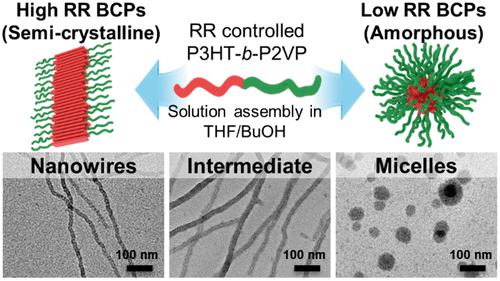当前位置:
X-MOL 学术
›
Chem. Mater.
›
论文详情
Our official English website, www.x-mol.net, welcomes your
feedback! (Note: you will need to create a separate account there.)
Modulating Regioregularity of Poly(3-hexylthiophene)-based Amphiphilic Block Copolymers To Control Solution Assembly from Nanowires to Micelles
Chemistry of Materials ( IF 7.2 ) Pub Date : 2018-09-29 00:00:00 , DOI: 10.1021/acs.chemmater.8b03510 Youngkwon Kim 1 , Hyeong Jun Kim 2 , Jin-Seong Kim 1 , Hongseok Yun 1 , Hyeonjung Park 1 , Junghun Han 1 , Bumjoon J. Kim 1
Chemistry of Materials ( IF 7.2 ) Pub Date : 2018-09-29 00:00:00 , DOI: 10.1021/acs.chemmater.8b03510 Youngkwon Kim 1 , Hyeong Jun Kim 2 , Jin-Seong Kim 1 , Hongseok Yun 1 , Hyeonjung Park 1 , Junghun Han 1 , Bumjoon J. Kim 1
Affiliation

|
In selective solvents, poly(3-hexylthiophene) (P3HT)-based block copolymers (BCPs) assemble into one-dimensional nanowires (NWs) due to strong π–π stacking interactions of the P3HT block. Herein, we report the effect of P3HT regioregularity (RR) on the assembly of P3HT-based amphiphilic BCPs in solution. We synthesized a series of P3HT-block-poly(2-vinylpyridine) (P3HT-b-P2VP) copolymers with similar molecular weights and P3HT volume fractions but with different RRs, ranging from 55% to 95%, and studied their assembly in tetrahydrofuran/n-butanol mixtures. P3HT-b-P2VP copolymers with high RR (>80%) crystallized into well-ordered NWs with core widths consistent with fully extended P3HT chains. In BCP nanostructures with decreasing RR, more flexible P3HT chains produced gradual increases in the width of the NWs, from 12 to 24 nm. Eventually, a morphological transition to spherical micelle structures was observed at 55% RR. The structural differences were visualized by incorporating Au nanoparticles, which locate at the interface of P3HT and P2VP blocks, onto the NWs and imaging the resulting hybrid nanostructures by transmission electron microscopy. In addition, the crystalline behaviors of the assembled nanostructures were determined using differential scanning calorimetry and grazing incidence X-ray scattering. We elucidated important relationships between the solution assembly behaviors and the crystalline interactions of conjugated semicrystalline–coil BCPs, which will guide design of future versatile BCP nanostructures.
中文翻译:

调节基于聚(3-己基噻吩)的两亲嵌段共聚物的区域规则性,以控制从纳米线到胶束的溶液组装。
在选择性溶剂中,由于P3HT嵌段强烈的π-π堆积相互作用,聚(3-己基噻吩)(P3HT)基嵌段共聚物(BCP)组装成一维纳米线(NWs)。在本文中,我们报道了P3HT区域规则性(RR)对基于P3HT的两亲BCP在溶液中的组装的影响。我们合成了一系列P3HT-嵌段-聚(2-乙烯基吡啶)(P3HT- b -P2VP)共聚物,它们具有相似的分子量和P3HT的体积分数,但具有不同的RR,范围从55%到95%,并研究了它们在四氢呋喃中的组装/正丁醇混合物。P3HT- b具有高RR(> 80%)的-P2VP共聚物结晶为排列整齐的NW,其核宽与完全延伸的P3HT链一致。在具有降低的RR的BCP纳米结构中,更灵活的P3HT链使NW的宽度逐渐增加,从12纳米增加到24纳米。最终,在55%的RR下观察到向球形胶束结构的形态学转变。通过将位于P3HT和P2VP嵌段界面的Au纳米颗粒掺入NWs并通过透射电子显微镜对所得的杂化纳米结构进行成像,可以看到结构差异。另外,使用差示扫描量热法和掠入射X射线散射确定组装的纳米结构的晶体行为。
更新日期:2018-09-29
中文翻译:

调节基于聚(3-己基噻吩)的两亲嵌段共聚物的区域规则性,以控制从纳米线到胶束的溶液组装。
在选择性溶剂中,由于P3HT嵌段强烈的π-π堆积相互作用,聚(3-己基噻吩)(P3HT)基嵌段共聚物(BCP)组装成一维纳米线(NWs)。在本文中,我们报道了P3HT区域规则性(RR)对基于P3HT的两亲BCP在溶液中的组装的影响。我们合成了一系列P3HT-嵌段-聚(2-乙烯基吡啶)(P3HT- b -P2VP)共聚物,它们具有相似的分子量和P3HT的体积分数,但具有不同的RR,范围从55%到95%,并研究了它们在四氢呋喃中的组装/正丁醇混合物。P3HT- b具有高RR(> 80%)的-P2VP共聚物结晶为排列整齐的NW,其核宽与完全延伸的P3HT链一致。在具有降低的RR的BCP纳米结构中,更灵活的P3HT链使NW的宽度逐渐增加,从12纳米增加到24纳米。最终,在55%的RR下观察到向球形胶束结构的形态学转变。通过将位于P3HT和P2VP嵌段界面的Au纳米颗粒掺入NWs并通过透射电子显微镜对所得的杂化纳米结构进行成像,可以看到结构差异。另外,使用差示扫描量热法和掠入射X射线散射确定组装的纳米结构的晶体行为。











































 京公网安备 11010802027423号
京公网安备 11010802027423号